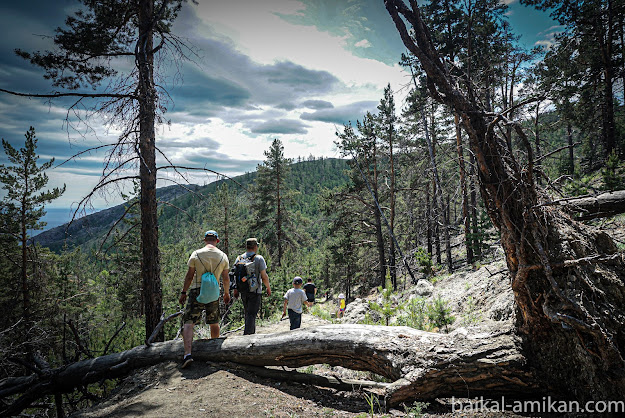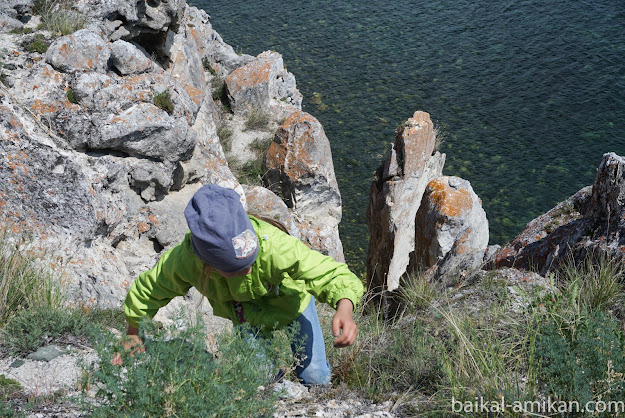Magical bay on lake Baikal - "Sagaan-Zaba".
If anyone asks me about my favourite place on Baikal, I may talk about several places like that. But this bay "Sagaan-Zaba" is one of the most remarkable places and one of my favourite. Not many people have visited this place, as it is not so popular. But it is unique and has its own magical atmosphere. Cars cannot reach this bay, so you may get here only on foot or by boat from water-side.
Dark cliff. White cliff. "Sagaan-Zaba" means "White Rock (cliff)" from the language of local people of Baikal. On the steep wall one may find petroglyphs - ancient rock drawings. When four hundred years ago, Cossack gangs invaded an unknown country and saw cave paintings, they decided that these were not just drawings, but letters left by its ancient inhabitants. That's why they called them "scribes" or "written stones." Indigenous people considered these rocks sacred places of their ancestors, drawings - works of spirits and surrounded them with an atmosphere of worship.
In the XIX century on the Sagan-Zab the figure of an elk was still preserved, the body of which was covered with transverse stripes. By analogy with the cave paintings found elsewhere in Siberia, this detail is characteristic of the taiga art of the Bronze and Early Iron Ages. That is, the approximate age of the writers on Lake Baikal is 4-5 thousand years.
In the bay of Sagan-Zaba there was a site of an ancient man of the Neolithic era, which means that the age of these petroglyphs is more than 4000 years. In addition to cave paintings in Sagan-Zab, the remains of fossil animals were discovered: a cave lion, a woolly rhinoceros, a giant deer horn.
The cave paintings of Sagan-Zaba are a composition of figures of people, animals and birds.
At the time of the discovery, in 1881, there were about 60 drawings: about 30 figures of people, 17 images of animals and 13 birds. The drawings occupied a section of rock up to seven meters in length and almost five meters in height. The sizes of the images themselves are from 1 centimeter to 50 centimeters. At present, some of the drawings have been lost for various reasons. Some, located in the lower part of the composition, are smoothed out by the waves, others are destroyed by people.
The earliest ancient drawings on the Sagan-Zaba cliff were made by the method of spot knocking out, later - carved lines. A characteristic detail of the cave paintings of people on a cliff is small horns on their heads. This may mean that people are not depicted, but spirits or shamans. Among the drawings there are images of deer, bulls, dogs, geese, swans.
These "marble seals" are laying on the shore getting warm after ice Baikal water under sunshine.
In the Kurykan legend, it is said that the giant-eyed moose named Hoglen stole the day on earth and ran with him through the sky. The hunter Mani chased after him, who left behind a wide trail - the Milky Way. Mani wounded Hoglen with an arrow, robbed him of his day, and returned to earth. Since then, every night, the moose kidnaps the day, and the night chase begins. An equally vivid image of the cosmic beast-moose exists among the forest Indian tribes of North America.
I can climb over these hills all day long, looking under holes and exploring the archs which are made by wind and sun the stone. From the Zun-Sagan-Zaba valley, you can climb to the top of the cliff for 15-20 minutes, from where a magnificent view of Lake Baikal opens. The very top of the cliff, overgrown with rare larches, is quite unusual due to the deep (15–20 m) funnel with a diameter of 40–50 m. Interesting forms of weathering give originality to the slopes of the cliff. Limestone is not durable material, easily inferior to rains, the sun and the fierce Baikal winds, even ground squirrels dig their minks without any difficulty. Due to this property of crystalline limestone, funny formations can be found on the slopes of the cliff.
Crater
Interstring fact is that three funnels at once are located in one place on the shore of Lake Baikal, and all three are on one of the slopes of Sagan-Zaba Bay. One funnel is particularly impressive for its gigantic size. The diameter of this bowl is about 100 meters, the depth is about 20 meters, located on the top of the southern slope. The origin of these funnels has different hypotheses. It is worth going down to the bottom of a huge bowl. The second funnel has a diameter of about 25 meters and a depth of about 15 meters. The third, the smallest, has a diameter of about 6 meters and a depth of about 2.
Kids like climbing the slopes in search of treasures, as according to one legend Chinese hid their treasures somewhere on the slope during their voyage across lake Baikal.
Once there was a cave on the top of the Sagan-Zaba cliff, information about which is very contradictory. According to some sources, the entrance to the cave has been lost for a long time, maybe it was destroyed by local residents or collapsed during the next earthquake. From other sources it follows that the cave was well known until recently and even archaeological finds were made in it. There is a legend associated with the cave, according to which gold is hidden in the depths of the cave, which the Chinese carriers could not cross over Lake Baikal.
The path to the pay is picturesque itself. It is covered with red needles of Siberian larch tree. We love this place and think it is best for visiting with family and kids.
If you would like to visit this place, you may check this tour to lake Baikal or contact us so that we create an individual tour for you!
...
By the way, the elk or maral depicted on the White Rock lies, bending its knees and throwing heavy curls of horns on its back, just like animals on items from Scythian barrows. Preserved on the rock and drawings of human figures. They have horns on their heads, their arms are raised up in a ritual gesture, their legs are bent in the shape of a rhombus. This is the pose of the ritual dance - the ritual. Shamans are painted and standing on full height on deer, and climbing a tree. In the memory of the Buryats and Yakuts legends of their common ancestors Kurykans about the space deer, which is the embodiment of the deity of the Sun, are preserved. This deer or elk rushes through the universe. Being born, he rises through the vault of heaven, then moves to sunset and dies, disappearing into the depths of the underworld. The cult of the solar god was formed even by primitive people and found embodiment in the image of a celestial moose pursued by a hunter.
So, come, visit this place yourself, and you will feel all the magic of this bay! Sagaan-Zaba....












Комментарии
Отправить комментарий